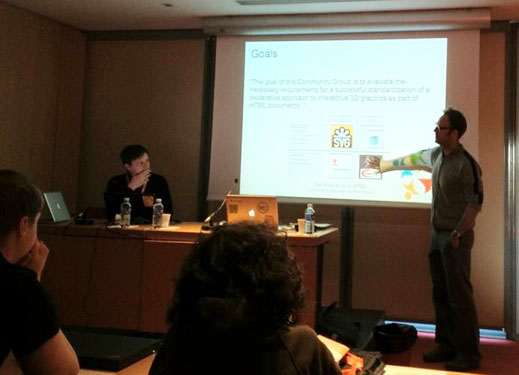2012 Declarative 3D workshop Report
The 1st International Workshop on Declarative 3D for the Web Architecture (Dec3D2012) was held at the WWW2012 conference in Lyon, France on April 17, 2012. This workshop was organized by the Declarative 3D W3C community groupled by DFKI, Fraunhofer and the Web3D Consortium.

We examine the requirements, options, and use cases for an integration of interactive 3D graphics capabilities into the W3C technology stack in a declarative way. While imperative graphics APIs are powerful and necessary, a ‘Declarative 3D’ approach can provide web authors an easy way to add interactive high-level declarative 3D objects through the HTML Document Object Model (DOM) allowing web authors to easily create, modify, share, and experience interactive 3D graphics using HTML documents.
The workshop was an open platform to discuss the Declarative 3D initiative and also present current technologies, demonstrations, and research papers on Declarative 3D. It was apparent from this workshop that there is a need and interest for a Declarative 3D solution for the Web. Participation, coordination and collaboration between industry, browser vendors, developers and standards organizations are necessary for Declarative 3D to become a seamless part of the Web infrastructure.
The workshop started with an overview and motivation for the Declarative 3D effort followed by the keynote speech by Robin Berjon who presented the harmonious path to HTML based on his experiences with SVG standardization. Following the keynote speech were demonstrations of innovative applications that deeply integrate 3D graphics and HTML, among others, Fraunhofer and DFKI reported on X3DOM and XML3D as models for an easy to use 3D hypermedia publishing frameworks. Two research track sessions consisted of interesting presentations on Declarative 3D Requirements, Use Cases, Visualization, Semantics and Services presented by researchers from around the world. The workshop ended with a discussion moderated by Ivan Herman (W3C) on how to achieve success in moving this effort forward as a W3C working group and eventually a W3C Declarative 3D standard.
The participants of the workshop agreed that what is needed to make the effort successful and for the W3C to adopt/develop a declarative 3D standard is:
- Active participation from the industry, browser companies, standards organizations and content developers;
- A clear definition of use cases and requirements for Declarative 3D;
- Initial draft specification document;
Work is in progress, gathering use cases and deriving requirements from these use cases. This group will present common use cases that define how 3D might intersect and interact with HTML5, DOM events, CSS, SVG, GeoLocation, Augmented Reality (AR), Efficient XML Interchange (EXI) and other key working groups. Certain complex data types and computations are also of mutual interest.
We are hoping the Declarative 3D approach interests the industry and browser companies and we look forward to your active participation. The W3C “Declarative 3D community group is not restricted to W3C members and is open to the public.


